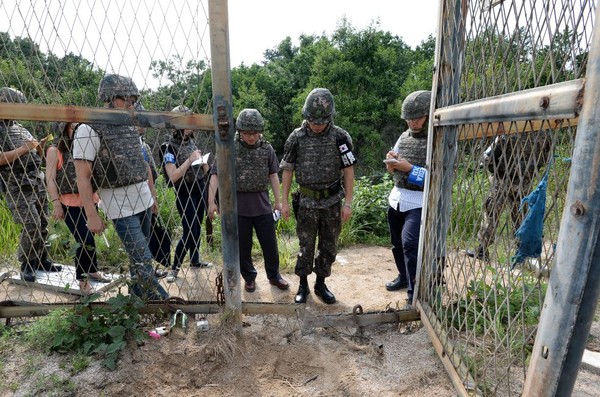- California Assembly OKs highest minimum wage in nation
- S. Korea unveils first graphic cigarette warnings
- US joins with South Korea, Japan in bid to deter North Korea
- LPGA golfer Chun In-gee finally back in action
- S. Korea won’t be top seed in final World Cup qualification round
- US men’s soccer misses 2nd straight Olympics
- US back on track in qualifying with 4-0 win over Guatemala
- High-intensity workout injuries spawn cottage industry
- CDC expands range of Zika mosquitoes into parts of Northeast
- Who knew? ‘The Walking Dead’ is helping families connect
N. Korea behind recent mine explosion in DMZ: Defense Ministry

In this Aug. 9, 2015, photo provided by the Defense Ministry, an unidentified South Korean army official, second from right, gives a briefing to the media at the scene of a blast inside the demilitarized zone in Paju, South Korea. Vowing to hit back, South Korea said Monday, Aug. 10, 2015, that North Korean soldiers laid the three mines that exploded last week at the border and maimed two South Korean soldiers. (The Defense Ministry via AP)
SEOUL (Yonhap) — North Korea is believed to have masterminded the bloody explosion of land mines in the demilitarized zone last week, the Defense Ministry said Monday, in the latest military provocation by the North, happening just weeks before a scheduled joint military exercise between South Korea and the U.S.
The mine blasts took place on the morning of Aug. 4 on the southern side of the DMZ near the city of Paju, Gyeonggi Province, while eight South Korean Army troops carried out a regular scouting mission there. The explosion severed the legs of two staff sergeants.
North Korean wooden-box mines were the cause of the blast, said Army Brig. Gen. Ahn Young-ho, who headed a joint probe into the incident, referring to mine debris found in the site.
“It is clear the enemy has deliberately laid the mines with an intention to inflict harm on our operational forces,” Ahn said. “The explosives are clearly wooden-box mines that the North Korean army is using.”
The design and types of the wood cases, three spring parts and the Trinitrotoluene explosive material, or TNT, found at the explosion site were cited as evidence supporting the conclusion.
The North Korean plot may be intended to derail the upcoming Ulchi Freedom Guardian (UFG), the annual war simulation exercise scheduled to take place next week between South Korea and the U.S. to prepare for a potential incursion by North Korea, an official at the Joint Chiefs of Staff said.
“It seems to be aimed at interrupting the scheduled implementation of UFG by obscuring who did the provocation and spurring discord inside South Korea over it,” the JCS official said.
The Paju border area is also where the two Koreas exchanged machine gun rounds last October after South Korean activists launched anti-Pyongyang propaganda leaflets into the North Korean side.
He likened the latest blast to the North’s deadly torpedoing of the South Korean Navy Corvette Cheonan in March 2010. North Korea has not yet accepted responsibility for the torpedo attack, despite much evidence showing otherwise.
A couple of North Korean soldiers may have secretly crossed the military demarcation line and come 440 meters further south to bury the mines around a South Korea Army-guarded gate that opens to the DMZ, possibly between July 26 and Aug. 1, the Army brigade general said.
The DMZ is a four kilometer-wide arms-free buffer running between the two countries which have been under a ceasefire since the 1950-53 Korean War. In actuality, the width is less than 4 km as the countries’ troops moved closer to the demarcation line which bisects the DMZ as part of tighter vigilance operations.
The accident site had previously been a mine-free zone where South Korean troops conduct regular search missions and there’s no possibility of the North Korean mines being washed up there, the army official said, backing up the conclusion of the probe.
The suspected mine laying by North Koreans, however, was not detected during the South Korean military’s regular surveillance operations possibly due to heavy fog seen in the area recently as well as heavy forest blocking the view during the summer, he said.
Following the explosion, the JCS has ordered heightened war-readiness positions among the servicemen and issued caution over the possibility of more mines being buried than the three that went off last week, military sources said.
In his capacity as the commander of the United Nations Command, the U.S. Forces Korea Commander Gen. Curtis M. Scaparrotti has also endorsed the recent conclusion during a recent telephone call with JCS Chairman Adm. Choi Yoon-hee, the sources said.
It was the first explosion by North Korea-laid explosives within the heavily-fortified DMZ since similar incidents took place in the mid-1960s, possibly a violation of the armistice which prohibits military action in the buffer zone.












![일본 사도광산 [서경덕 교수 제공. 재판매 및 DB 금지]](http://www.koreatimesus.com/wp-content/uploads/2024/07/PYH2024072610800050400_P4-copy-120x134.jpg)


